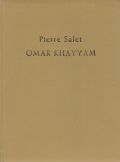Op hun gevleugelde gedachten. Over P.C. Boutens en de Rubaiyat van Omar Khayyam. Rianne Batenburg. Utrecht, Rijksuniversiteit Utrecht, Faculteit Letteren, 2004.
Afstudeerscriptie
Archives
Elihu Vedder’s Rubáiyát
Elihu Vedder’s Rubáiyát. Sylvia Yount.
American Art, 29 (2015), 2, pp. 112–118.
The distinctive work and career of Elihu Vedder have proven difficult to categorize in the history of American art. Part academic naturalist, part progressive symbolist, the artist is best remembered for his allegorical and literary paintings. Yet a more contextual examination of Vedder’s production challenges the standard view of him as a visionary out of step with the art world of his time and unconcerned with the broader cultural reach of his work.
Love and Death in Elihu Vedder’s Rubáiyát of Omar Khayyám
Love and Death in Elihu Vedder’s Rubáiyát of Omar Khayyám. Akela Reason.
American Art, 29 (2015), 2, pp. 119–125.
Spiritual uncertainty figured in many of Elihu Vedder’s works. The artist acknowledged his fascination with this theme, writing in his autobiography, The Digressions of V., “it delights me to tamper and potter with the unknowable, and I have a strong tendency to see in things more than meets the eye.” Especially preoccupied by the mystery of death, Vedder returned to the subject again and again. Death comes in many forms in Vedder’s art—from “all-devouring” sphinxes presiding over desert wastes to the fratricidal conflict of the Old Testament, and devastating medieval plagues.
The Rubáiyát and its compass
The Rubáiyát and its compass. Annmarie Drury.
In: Translation as Transformation in Victorian. Annmarie Drury. Cambridge, Cambridge University Press, 2015. pp. 147-191.
Edward FitzGerald described his translation of Omar Khayyám’s Rubáiyát, which he produced in four versions ranging from 75 to 101 stanzas, as centered on the theme of carpe diem. In musical terms, the poem might be described as variations on that theme; in visual terms, as a kaleidoscopic exploration of it. Following the lead of Omar Khayyám (1048–1131), a Persian poet and scientist, FitzGerald made his Rubáiyát elaborate a philosophy of “seizing the day”: through lamentation, through the recounting of personal experience, through bald assertions of defiance against conventional piety, through metaphorical representations of a world in which human beings lack meaningful volition, and through vignettes – especially the longest, most fanciful one, in which the poem’s speaker overhears a group of pots speculating about their creator.
Khayyam who thinks and speaks Albanian
Khayyam who thinks and speaks Albanian. Abdulla Ballhysa; Mirela Shella.
Anglisticum Journal 2 (2013) 2, pp. 6-13
According to the Albanologist R. Jokli, Noli’s Rubaiyat stands as the best of the many translations of Fitzgerald’ version, but this translation, almost a recreation, can be considered his dearest, closest and most spiritual. Probably in none of his works did Noli express himself the way he did while translating (or better say culturally adapting into Albanian) Rubaiyat. This is the work in which he expressed his thoughts and his troubles, his vulcanic character, his creative courage, his tolerance, his humanity and his longing for freedom.
Khayyám’s universal appeal: man, wine, and the hereafter in the quatrains
Khayyám’s universal appeal: man, wine, and the hereafter in the quatrains. A.A. Seyed-Gohrab.
In: The great ‘Umar Khayyám. Leiden, Leiden University Press, 2012. pp. 11-38.
Introductory essay, in which the author discusses a number of aspects in respect to the study of Omar Khayyám and his rubáiyát: the contents of the quatrains; man, the world and the hereafter; doubt versus certainty; the knot of death; flora and fauna; the pot and the pot-maker; who is the beloved; people with discernment; in vino veritas; activities in the world.
Omar Khayyam: savant et philosophe
Omar Khayyam: savant et philosophe. Pierre Salet. Paris, Maisonneuve Frères, 1927
Sufi symbolism in Tolib Shakhidi’s televised ballet The Rubaiyat of Omar Khayyam
Sufi symbolism in Tolib Shakhidi’s televised ballet The Rubaiyat of Omar Khayyam. Marina N. Drozhzhina, Sitora D. Davlatova
Music Scholarship, 2018, Nr. 1, pp. 66-73
